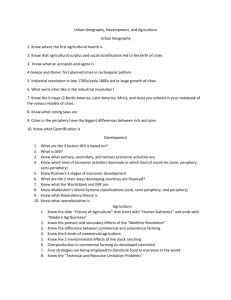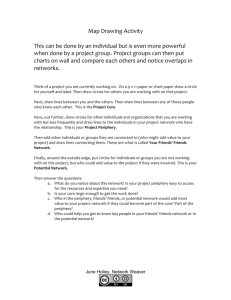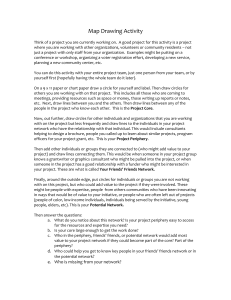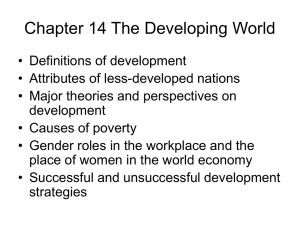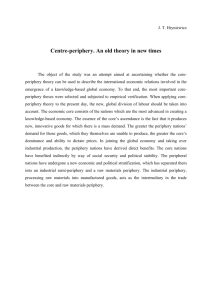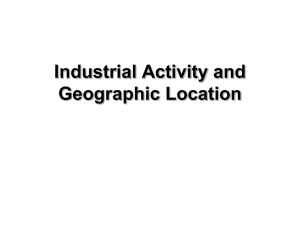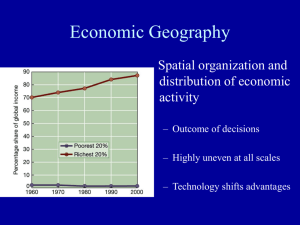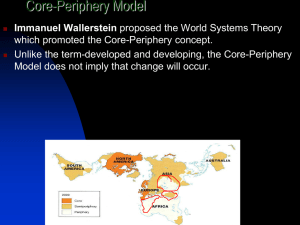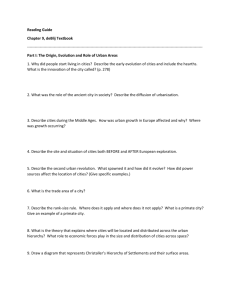AP HUGE econ geo
advertisement
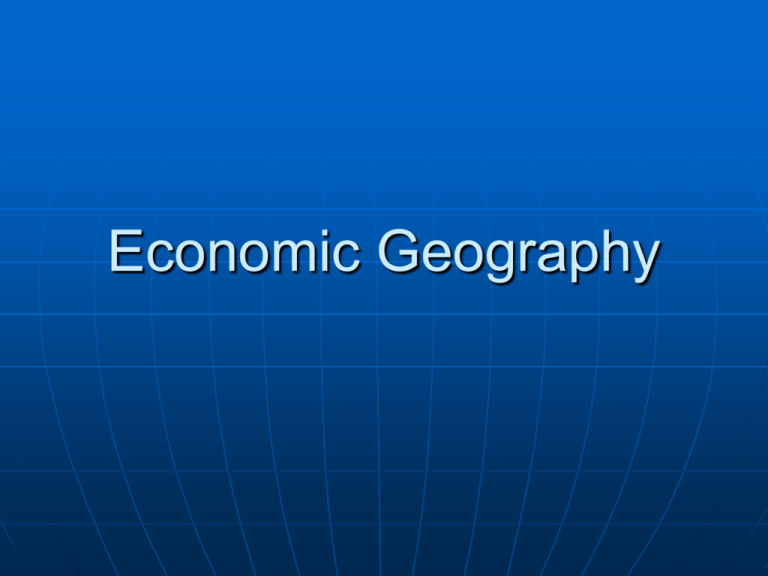
Economic Geography Economic Geography The study of the flow of goods and services through space, as well as how people provide for themselves in different places. Commodity Chain Linking producers to consumers Classification Underdeveloped, Developed, and Developing Nations: • To say a country is underdeveloped would be politically incorrect, in light of the fact that the word underdeveloped had a negative connotations geographers developed a new way to groups nations in the core-periphery model. This model characterized nations into either: core, semi-periphery, and periphery nations. Measures of Development GNP-the measure of all the goods and services produced by a country in a year. • Provides a very vague vision of productivity. For it fails to account for the lost through the exploitation of natural resources. GDP- similar to GNP but it omits any investments abroad. Example: Japan has a huge amount of investments abroad there for the GNP would be significantly larger than the GDP. Classification Characteristics of a Core Nation: • Have achieved high levels of socioeconomic prosperity and high standards of living • Contain world cities such as London, Tokyo, and New York which serve as global centers of economic activity. • These nations include the U.S., Germany, Great Britain. • Technology, Education, Research Characteristics of a Semi-Periphery Nation: • Newly industrialized countries with diverse economic opportunities but have extreme gaps between rich and poor. • These nations are usual in a transition stage to becoming a core nation. • Examples: Chile, brazil, India, China, and Indonesia Classification Characteristics of a Periphery Nations: • Usually poor regions that are very dependent upon core nations. • Low levels of economic productivity and lack infrastructure and have rapidly growing populations. • These place have benefited little from globalization. Keep in mind that the core-periphery model focus on the economic relationships among places. The “slow word” of the periphery is often compared to the “fast world” of the core because of the lack of technology and communication in periphery nations. Advantages of Production in Periphery Nations 1) 2) 3) 4) 5) Cheap Labor Loose Labor Laws Loose Environmental Regulations Low Taxes The distribution of natural resources by locating different aspects of production in different countries. • Note: Most MNC’s are conglomerate corporations: composed of many smaller firms that serve different functions. (i.e. distance to natural resources) World-System Theory Immanuel Wallerstein said “the world was and interdependent system of countries inked by political and economic competition.” When political and economic relations strengthened the areas connected (core nations) begin to thrive but the nation not connected (periphery nations) did not get these new technological advancements and innovations. This was Wallerstein’s theory as to why there are core, periphery, and semi-periphery nations. Impact of Industrialization/Development Neocolonialism: the entrenchment of the old colonial system under a more economic than political society. Tourism usually places a negative affect on periphery nations because eventhough it may support an economy it may take away from the local culture. It also takes away from the local entrepreneurs. • Tourism may promote awareness about a particular culture and intercultural contact it takes a harsh turn on the cultural landscape. Models of Development ~Liberal Model ~ Assume that all counties are at the same stage All countries are capable of development ~Structural Model~ general term for models of economic development A result of historically derived power relations within the global economic system Only certain countries can become developed The structure is already in place (maquiladoras) Modernization Model-Rostow (1960) This model states that all countries follow a similar path through 5 stages of development. • Traditional: subsistent farming, rigid social structure, little technological change. • Preconditions: progressive leadership, diversification, more flexibility Introduction to technology such as the steal plow Ability to mass produce food Infrastructure is built Development of political organization Charismatic leader Modernization (continued) • Take-off: Manufacturing, some type of industrial revolution, sustained grown occurs. Urbanization increases, industrialization continues, mass production. • Drive to Maturity: technology diffuses, specialization, international trade, modernization, population growth. Modernization (continued) • High mass consumption: High incomes, Widespread productions, mainly service sector jobs. International trade Dependency Theory The structuralist view to Rostow’s model. Relationship between countries control and limit economic development • Development does not happen everywhere due to dependence on a core nation for money Industrialization (Regions) Soviet Union: 90% of coal mined. • • • Largest manufacturing complexes. After WWII, industrialization continued. Dames were created. Lack of coal with poor quality. Four Tigers: South Korea, Taiwan, Hong Kong, and Singapore. • Tied to a shift in labor intensive industries. • Created mainly automobiles, grand pianos to calculators and computers. Europe: Began to expand after WWI • Began in Italy, Spain and Scandinavia • Successful in the Ruhr • Industry rebounded through much of the continent while maintaining its position in the globe Industrialization (continued) North America: • U.S. was the industrial power • Canada was a big part as well • American manufacturing Belt was formed and extended Russia/Ukraine • St. Petersburg • Ukraine was threatened by the German army WWII • Reassembled in Samera Changing World The Fall of the Soviet Union: • Led to the establishment of international boundaries. For example Ukraine became independent and Russia lost one of it key industrial heartlands, which took a toll on the supranationalism that was established. • Major Political and Economic Changes in: Mexico, Brazil, Thailand, and Malaysia • Until the end of the 1980’s there were three major political-economic blocs: First World: The Capitalist Second World: The Communist Third World: Mainly mixed economies • Due to the collapse of the Soviet Union, and the new polcies implemented by Tanzania, and Ethiopia the 3rd World party was no more. Industrialization (continued) Eastern Asia • Japan and China • Where large-scale industrialization 1st took place China • Industrial expansion took place during communism time • Included manufacturing districs Japan • Limited resources • Main manufacturing made from raw materials imported from the whole world • Established colonies • Four Japanese districts Secondary Regions Special Economic Zones (SEZ) • “Open Cities” and “open coastal areas to encourage foreign investment Secondary areas • Thailand, Malaysia, Indonesia, and Vietnam (possibly the Philippines • Most of the pacific rim Categories of Economic Activities Primary Economic Sector: • These are the countries that harvest and extract raw materials. • Activities include fishing, agriculture, ranching, and mining. • Nations who do these kinds of activities are usually undeveloped nations trying to grow their economy. • Examples: Vietnam, Laos Secondary Economic Sector: • These are the countries that are associated with the assembly of raw materials in to goods for consumption. • Activities include: Manufacturing, production of metal, and textile production. • This type of activity is characteristic to undeveloped and developing nations. • Example: Japan Categories of Economic Activities continued Tertiary Economic Sector: • Involved with the exchange of goods produced, from the manufacturer to consumer in the secondary service sector. • Activities include: offices, banks, hospitals, and other basic service jobs. • These Nations are usually developing and sometimes developed nations. Quaternary Economic Sector: • Research and development, teaching, tourism, and other activities that have to do with generating or exchanging knowledge. • These jobs usually require a higher level of education and are characteristic to developed nations. • Examples: U.S., Great Britain, Germany Deindustrialization Deindustrialization is when industrial facilities leave an area, taking the economic base with them. • This occurred in places like the Midwest, Central Britain, the Great Lakes, and Flint, Michigan. Example: Flint’s economic base was in General Motor’s automobile industry. It moved to Mexico for: 1)Cheaper Labor, 2) Flexible environmental regulations, 3)Inexpensive Land, and 4) Enticing tax breaks. Because of this the economy went into a slump. This par of the Midwest is now known as the Rust Belt. Deindustrialization Continued When one region’s economic gain translate into another’s economic loss it called the backwash affect also know deglomeration when a firm leaves a region for to start up in a distant place. One of the main reason firms began to move is because of the time-space convergence which is when the absolute distance between to places decreases because of the increase in technology and communication. While deindustrialization was hurting some regions other were experiencing a different kind of economic rev or “high tech boom”. With the rise of this new economy, nations became transnational or MNC’s (Multi National Corporations). • The rise of these new transnational nations was attributed to the advantages of production in periphery nations. Deindustrialization Continued Export-processing zones were also created through deindustrialization. These zones wer designated for manufacturing, and were often accessible for distribution, and worked well with the 5 advantages to production in periphery nations. • In North America NAFTA was created in 1994 as a result of deindustrialization. This agreement allowed for free trade between the U.S., Canada, and Mexico. This brought economic growth and rising standards of living, which also strengthened the rules and procedures governing trade and investment. Shifts in Manufacturing Heavy industries were limited to N. Europe, E. Asia, N. America, Britain, France, Russia, Germany and Japan. These countries were known as industrial countries. • The geography of industrial production has shifted from core nations to periphery nations. Many firms have relocated their factories to less-developed nations where it is cheaper to produce goods. For example when Multinational Corporations moved their factories to Mexico called Pre-industrial World Industrial development did not being with the Industrial Revolution. It began during that period and diffused from certain areas of innovation to other parts of the world. Industrial Revolution During the 18th century, European markets were growing and there was not enough labor to keep pace with local or overseas trade. Better machines were needed the steam-driven engine was invented called the power loom, which revolutionized the weaving industry Affected transportation and communication . The 1st railroad was opened in 1819. The Industrial revolution diffused eastward. Weber’s Least Cost Theory Transportaion: The site chosen must entail the lowest possible cost of moving raw materials to the factory and finished products to the market. Labor: the availability of cheap semiskilled labor. • Low price goods • and low-wage workers. Agglomeration: happens when a substantial number of enterprises cluster in the same are in a large industrial city that can provide assistance to each other through shared talents, services and facilities. Shifts in Manufacturing Continued Wealthier nations were shifting to information and service-based economies. • Their focus was on research and development, marketing, tourism, sales and telecommunications. • These jobs generally provided better pay, safer working conditions, less pollution, and higher standard of living. Yet, they required more education. • Newly industrialized countries include: Mexico. China, and Malaysia. Impact of other Variables on Economics Infrastructure Energy Government
